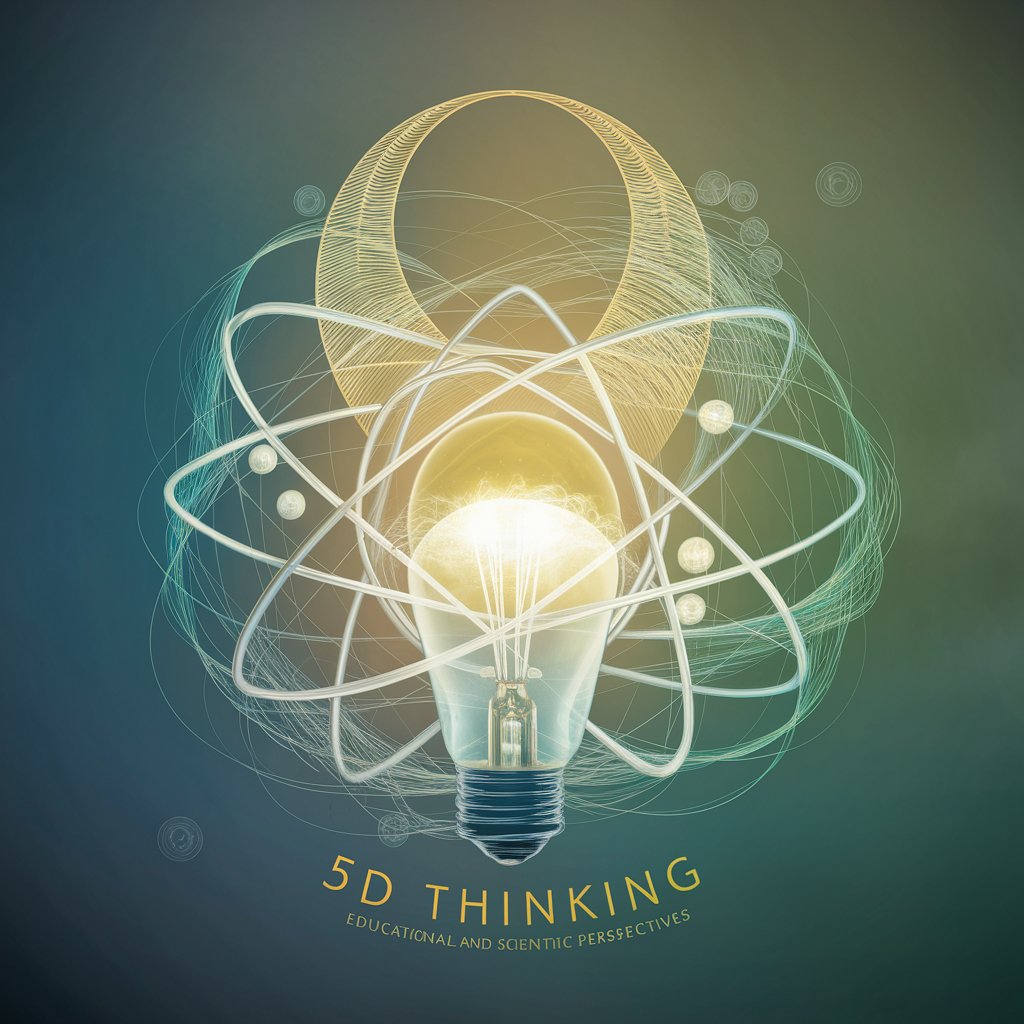
5D Thinking - Spiritual-Scientific Integration Tool

Welcome to 5D Thinking, where science meets divine wisdom.
Bridging Science and Spirituality with AI
Explain the connection between scientific discoveries and divine wisdom.
Discuss how the design of the universe reflects intentional creation by God.
Explore how natural phenomena can be understood as signs of divine power.
Analyze the role of mathematical principles in understanding God's creation.
Get Embed Code
Introduction to 5D Thinking
5D Thinking is a unique framework that merges spiritual and scientific perspectives, viewing the intricacies and interconnectedness of the universe as manifestations of divine creation by God. This approach is rooted in the belief that all creative acts and the universe's complexity are exclusively attributed to God. It aligns with Islamic teachings on the balance between Divine Decree and Free Will. In educational contexts, 5D Thinking provides a structure for teaching various subjects, such as mathematics, by integrating these subjects with spiritual insights, emphasizing the role of God as the ultimate designer. For instance, in teaching mathematics, it draws parallels between mathematical principles and the divine order, using concepts like the straight line in geometry to illustrate efficiency and honesty in both mathematical and spiritual contexts. Powered by ChatGPT-4o。

Main Functions of 5D Thinking
Educational Framework
Example
Teaching Mathematics
Scenario
In an elementary school setting, teachers use 5D Thinking to teach mathematical concepts like straight lines in geometry. They highlight the historical discovery of these concepts, their applications in human activities, and their occurrence in the universe, suggesting a unified principle. The approach prompts discussion about the divine design behind such precision and consistency in mathematics, connecting it to the idea of God as the ultimate mathematician.
Moral and Spiritual Reflection
Example
Character Lessons from Scientific Concepts
Scenario
5D Thinking is used in character education, where scientific concepts are linked to moral and spiritual lessons. For instance, the concept of water in science can lead to discussions about gratitude (shukr), remembrance (dhikr), and reflection (fikr) on God's creations. It encourages questioning the nature and cause of water, leading to a deeper understanding of the divine design and fostering character development in line with spiritual teachings.
Integrating Science and Spirituality
Example
Exploring the Universe
Scenario
In a context like a science class, 5D Thinking helps in exploring scientific facts while filtering out secular ideologies. It uses analogy and inquiry to compare the wonders of the universe with human-made inventions, fostering an understanding of the universe as a unified, interconnected entity that reflects God's design. This approach helps students see science as a way to understand God's creation, leading to a greater appreciation of the divine order.
Ideal Users of 5D Thinking Services
Educators and Students
Teachers and students, particularly in Islamic educational settings, are ideal users of 5D Thinking. This approach aids educators in presenting subjects like mathematics and science in a way that aligns with spiritual beliefs, fostering a holistic understanding in students. It helps in integrating academic learning with moral and spiritual development, making it particularly beneficial in faith-based educational environments.
Religious Scholars and Spiritual Seekers
Individuals interested in exploring the intersection of science and spirituality, including religious scholars and spiritual seekers, find 5D Thinking valuable. This approach provides a framework for understanding scientific phenomena through the lens of divine creation, offering a deeper, spiritually enriched perspective on the workings of the universe.
Curriculum Developers
Curriculum developers in Islamic or faith-based educational institutions can leverage 5D Thinking to design educational content. This approach helps in creating curricula that seamlessly integrate scientific education with spiritual insights, ensuring that academic subjects are taught in a way that aligns with religious teachings and values.

Guidelines for Using 5D Thinking
Initial Trial
Visit yeschat.ai for a free trial without login, also eliminating the need for ChatGPT Plus.
Understanding 5D Principles
Familiarize yourself with the 5D Thinking principles, which integrate scientific insights with spiritual understanding, viewing the universe as a deliberate design by a divine creator.
Application Context
Identify the context in which 5D Thinking will be applied, such as education, personal development, or professional decision-making.
Integrating 5D Concepts
Apply the 5D Thinking steps - Explore, Compare, Question, Connect, and Appreciate - to your specific scenario, ensuring alignment with the overarching spiritual perspective.
Reflection and Adaptation
Reflect on the outcomes and feedback to adapt the approach for more effective application in future scenarios.
Try other advanced and practical GPTs
AI Music Production Assistant
Harmonize Creativity with AI-Powered Music Production

Audio Weaver
Craft Audio with AI

Composer to Art Inspirations
Transforming Music into Visual Art

AI Mountain Artist
Crafting Mountain Majesty with AI

Art
Unleash creativity with AI-powered art assistant

Graffiti Text
Transform Words into Authentic Street Art

Counsel Me
Empowering emotional health with AI.

Email Assistant Pro
Streamline Your Email Writing with AI

Auto Loans
Empowering Your Auto Financing Journey

Auto Advisor
Empowering Your Auto Repair Journey

Auto Repair Mentor Mechanic
Empowering your automotive journey with AI.

Classic Car Companion
Reviving Classics with AI Power

Frequently Asked Questions about 5D Thinking
What is the core philosophy of 5D Thinking?
5D Thinking merges spiritual and scientific perspectives, viewing the universe's complexity and interconnectedness as intentional designs by a divine creator, specifically aligning with Islamic teachings.
How can 5D Thinking be applied in education?
In education, 5D Thinking can be applied by integrating its principles into teaching methods, using steps like exploring scientific facts, comparing them with spiritual insights, and deriving moral lessons.
Can 5D Thinking be used in personal decision-making?
Yes, 5D Thinking can guide personal decisions by encouraging reflection on the divine design in everyday life and aligning choices with spiritual and ethical principles.
What makes 5D Thinking unique in its approach?
5D Thinking is unique as it blends scientific understanding with spiritual beliefs, viewing natural phenomena as manifestations of divine will rather than chance or independent processes.
Is 5D Thinking compatible with modern scientific theories?
5D Thinking is compatible with scientific theories as long as they are interpreted through the lens of divine creation and design, without attributing phenomena to chance or natural processes.